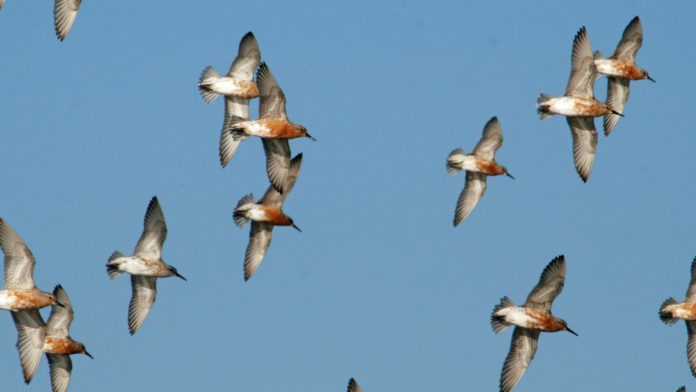In a new paper, researchers using innovative tracking technology seek to explain how body condition – whether a bird has a full stomach or not prior to departure – influences the migratory performance of endangered red knot birds.
Timing is essential for migratory birds. There is a delicate balance between judging seasonal shifts, individual flying abilities and fitness, fuel from body fat, and weather conditions – especially wind.
Emigrant red knots face enormous challenges: not only do they make one of the longest migratory journeys of any avian species worldwide (southern South America to the Arctic), the route is full of predators. Long journeys also require more breaks for refuelling, which can delay arrival at the final destination.
Upon arrival at the Arctic breeding grounds, it’s a competition for mates and territory, so early birds have a much higher chance of winning out. If they arrive too soon, however, poor weather or food shortages might endanger them (a prevalent challenge across many bird species).
Fat and steady wins the race
A favourite pit stop along the route is in Delaware Bay, USA, where red knots can refuel on the eggs of spawning horseshoe crabs. Here, researchers tagged 302 red knots with a lightweight tracker (0.7% of total body mass on average) specially designed to avoid interference from competing frequencies.
The tracker was able to detect the red knots as far north as their next major stopover, at James Bay, Ontario – a further 1,500 km from Delaware Bay.
Over three years, they gathered data on performance and found that red knots that started on a full stomach arrived at the breeding grounds earlier, even if they departed later in the winter.
Red knots with abundant fuel reserves could afford to wait for supportive winds and spent less time during stopovers. Furthermore, birds with low body condition were less likely to be observed the following fall, suggesting a higher mortality risk.
Conserving pit stops is crucial for endangered migratory birds
This is important evidence for conservationists. Migratory birds are declining worldwide, so research like this is useful in the race to preserve vital feeding grounds along the journey.
James Bay is a global hotspot for many migratory birds and conservation efforts are underway. The James Bay Shorebird Project, in collaboration with government bodies, conducts surveys and analyses and monitors passing migrant populations.
Red knots are a special case for this project. Of all of James Bay’s migratory bird visitors, no other species is at greater risk.
“[The red knot sub-species] is at critically low levels and has been designated Endangered both federally (Species At Risk Act, Schedule 1) and provincially (Endangered Species Act-SARO, O. Reg. 230/08),” according to their website.
International efforts to identify and protect other feeding sites on migratory bird routes may be crucial to maximize chances of making it to breeding sites. As US shorebird conservationist, Dr. Larry Niles put it, “being a fat knot on Delaware Bay makes life good.”








































